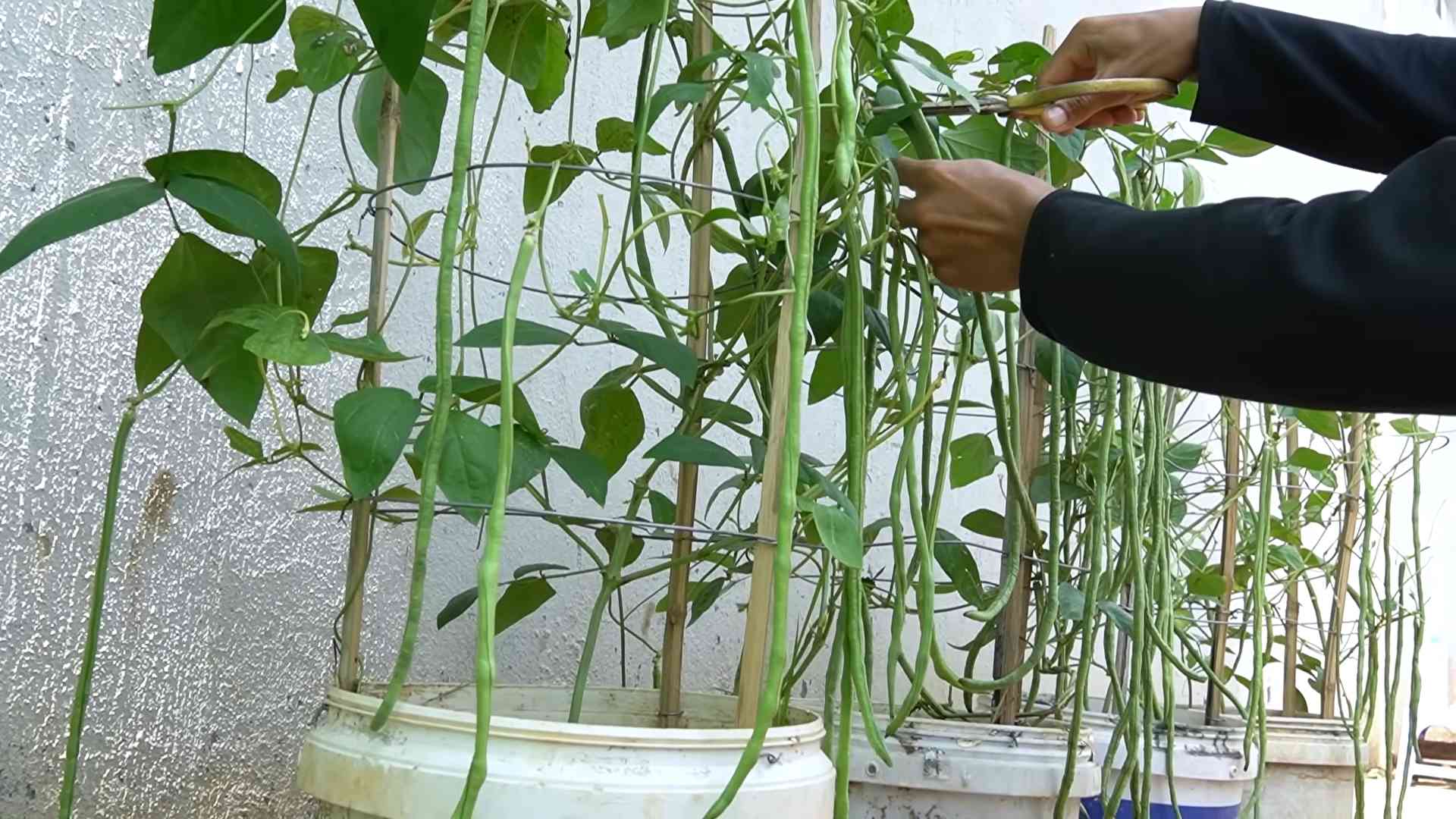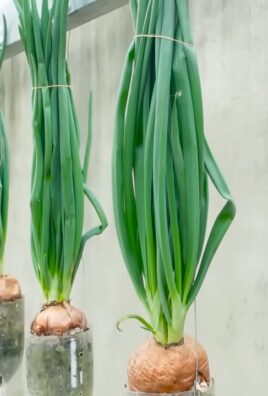Grow Long Beans Faster? Absolutely! Imagine harvesting armfuls of vibrant, delicious long beans from your own backyard, weeks ahead of schedule. It’s not just a dream; it’s an achievable reality with a few clever DIY tricks and hacks. For centuries, gardeners across Asia have treasured long beans, also known as yardlong beans or asparagus beans, not only for their unique flavor and impressive length but also for their nutritional value. These beans are a staple in many cuisines, representing a connection to the land and a source of sustenance.
But let’s be honest, waiting for your long beans to mature can feel like an eternity. That’s where these DIY solutions come in! I’m going to share some simple, yet effective, methods to help you grow long beans faster and enjoy a bountiful harvest sooner than you ever thought possible. Whether you’re a seasoned gardener or just starting out, these tips will empower you to maximize your yield and savor the satisfaction of growing your own food. Get ready to unlock the secrets to rapid long bean growth and transform your garden into a thriving oasis!

DIY: Supercharge Your Long Bean Growth!
Hey there, fellow gardeners! Are you dreaming of bountiful harvests of long, delicious beans but feeling impatient waiting for them to mature? I totally get it! Long beans, also known as yardlong beans or asparagus beans, are fantastic additions to any garden, but sometimes they can take their sweet time. Well, I’ve got some tried-and-true tips and tricks to help you accelerate their growth and get those beans on your plate sooner. Let’s dive in!
Choosing the Right Variety and Location
Before we even think about planting, let’s make sure we’re setting ourselves up for success.
* Variety Selection: Not all long bean varieties are created equal. Some are naturally faster growers than others. Look for varieties specifically labeled as “early maturing” or “bush type” if you’re short on space. Some popular and quick-growing options include ‘Red Noodle,’ ‘Chinese Red Noodle,’ and ‘Orient Wonder.’ I’ve had great luck with ‘Orient Wonder’ in my own garden.
* Sunlight is Key: Long beans are sun worshippers! They need at least 6-8 hours of direct sunlight each day to thrive. Choose a location in your garden that gets plenty of sunshine throughout the day. If you’re gardening in a shadier area, consider using grow lights to supplement the sunlight.
* Soil Preparation: Long beans prefer well-draining soil that’s rich in organic matter. Before planting, amend your soil with compost, aged manure, or other organic materials. This will improve drainage, aeration, and nutrient content, giving your beans a strong start. I like to add a generous amount of compost a few weeks before planting to give it time to break down.
Starting Your Long Beans Right
Now that we’ve got the basics covered, let’s get those beans started! You can either direct sow them or start them indoors. I personally prefer starting them indoors, especially if I want an earlier harvest.
* Direct Sowing: This is the simplest method. Once the soil has warmed up to at least 65°F (around 18°C), you can sow the seeds directly into the ground.
1. Prepare the Soil: Rake the soil smooth and remove any rocks or debris.
2. Sow the Seeds: Plant the seeds about 1 inch deep and 2-3 inches apart.
3. Water Gently: Water the area gently to avoid disturbing the seeds.
4. Thin Seedlings: Once the seedlings emerge, thin them to about 6-8 inches apart.
* Starting Indoors: This gives you a head start on the growing season.
1. Choose Your Containers: Use small pots or seed trays filled with seed-starting mix. I like to use biodegradable pots so I can plant them directly into the ground without disturbing the roots.
2. Sow the Seeds: Plant 2-3 seeds per pot, about 1 inch deep.
3. Water and Provide Light: Water gently and place the pots under grow lights or in a sunny window.
4. Harden Off Seedlings: Before transplanting the seedlings outdoors, you’ll need to “harden them off.” This means gradually exposing them to outdoor conditions over a period of 7-10 days. Start by placing them outside for a few hours each day, gradually increasing the amount of time they spend outdoors.
5. Transplant Seedlings: Once the seedlings are hardened off and the soil has warmed up, transplant them into your garden. Space them about 6-8 inches apart.
Boosting Growth with Proper Care
Once your long beans are planted, it’s time to provide them with the care they need to thrive.
* Watering: Long beans need consistent moisture, especially during hot weather. Water deeply and regularly, aiming for about 1 inch of water per week. Avoid overhead watering, as this can lead to fungal diseases. I prefer to use a soaker hose or drip irrigation to water directly at the base of the plants.
* Fertilizing: Long beans are heavy feeders, so regular fertilization is essential for optimal growth.
1. Initial Feeding: After transplanting or when seedlings emerge, feed them with a balanced fertilizer (e.g., 10-10-10).
2. Ongoing Feeding: Continue to fertilize every 2-3 weeks with a fertilizer that’s higher in phosphorus and potassium than nitrogen. This will encourage flowering and bean production. I like to use a liquid seaweed fertilizer, as it’s gentle and provides a wide range of nutrients.
* Support System: Long beans are climbing plants, so they need a support system to grow on.
1. Choose Your Support: You can use a trellis, fence, or even a teepee made of bamboo poles.
2. Install Support Early: Install the support system before the plants start to climb.
3. Guide the Vines: As the plants grow, gently guide the vines onto the support system.
* Mulching: Mulching helps to retain moisture, suppress weeds, and regulate soil temperature.
1. Choose Your Mulch: You can use organic mulches like straw, wood chips, or shredded leaves.
2. Apply Mulch: Apply a 2-3 inch layer of mulch around the base of the plants, being careful not to cover the stems.
Secret Weapons for Faster Growth
Okay, now for the really good stuff! These are some extra tips and tricks that I’ve found to be incredibly effective in boosting long bean growth.
* Epsom Salts: Epsom salts are a great source of magnesium, which is essential for plant growth. Dissolve 1 tablespoon of Epsom salts in 1 gallon of water and spray the plants every 2-3 weeks. I’ve noticed a significant difference in the size and vigor of my plants after using Epsom salts.
* Compost Tea: Compost tea is a liquid fertilizer made by steeping compost in water. It’s packed with beneficial microbes and nutrients that can boost plant growth and immunity.
1. Make Compost Tea: Place a handful of compost in a burlap sack or old pillowcase.
2. Steep in Water: Submerge the sack in a bucket of water and let it steep for 24-48 hours.
3. Dilute and Apply: Dilute the compost tea with water until it’s the color of weak tea. Use it to water your plants or spray it on their leaves.
* Pinching and Pruning: Pinching off the growing tips of the vines can encourage branching and more bean production. You can also prune away any yellowing or diseased leaves to improve air circulation and prevent the spread of disease.
* Companion Planting: Planting certain herbs and flowers near your long beans can help to attract beneficial insects and repel pests. Some good companion plants for long beans include marigolds, basil, and rosemary. I always plant marigolds around my vegetable garden to keep pests away.
Dealing with Pests and Diseases
Even with the best care, long beans can sometimes be affected by pests and diseases. Here’s how to deal with some common problems:
* Aphids: These tiny insects can suck the sap from your plants, causing them to weaken and yellow. You can control aphids by spraying them with a strong stream of water, using insecticidal soap, or introducing beneficial insects like ladybugs.
* Bean Beetles: These beetles can damage the leaves and pods of your long beans. You can control bean beetles by handpicking them off the plants, using row covers, or spraying them with neem oil.
* Fungal Diseases: Fungal diseases like powdery mildew and rust can cause white or orange spots on the leaves. You can prevent fungal diseases by providing good air circulation, avoiding overhead watering, and using a fungicide if necessary.
Harvesting Your Bounty
Finally, the moment we’ve all been waiting for – harvesting those delicious long beans!
* Harvest Time: Long beans are typically ready to harvest about 60-70 days after planting.
* Harvesting Technique: Harvest the beans when they are young and tender, before the seeds inside become too large. Use scissors or pruning shears to cut the beans from the vine.
* Regular Harvesting: Harvest the beans regularly to encourage continued production. The more you harvest, the more beans the plants will produce!
By following these tips and tricks, you’ll be well on your way to enjoying a bountiful harvest of long beans in no time. Happy gardening!

Conclusion
So, there you have it! This simple yet effective DIY trick for growing long beans faster is a game-changer for any gardener, whether you’re a seasoned pro or just starting out. We’ve walked you through the process, highlighting how this method can significantly reduce the time it takes to harvest those delicious, tender long beans.
Why is this a must-try? Because time is precious! This method allows you to enjoy the fruits (or rather, vegetables!) of your labor sooner, extending your harvest window and maximizing your yield. Imagine serving up fresh, homegrown long beans weeks earlier than you thought possible. That’s the power of this technique.
But the beauty of gardening lies in experimentation. Feel free to adapt this method to your specific needs and environment. For instance, if you live in a particularly hot climate, consider using a shade cloth to protect your seedlings from scorching. You could also experiment with different types of organic fertilizers to further boost growth. Another variation could involve using different types of support structures for your long bean vines. Some gardeners prefer trellises, while others opt for teepees or even repurposed materials like old ladders. The key is to find what works best for you and your garden.
Don’t be afraid to get creative! You could even try companion planting alongside your long beans. Marigolds, for example, are known to deter pests, while basil can improve the flavor of your beans. The possibilities are endless!
We are confident that this DIY trick will revolutionize your long bean growing experience. It’s easy, cost-effective, and yields impressive results. But don’t just take our word for it – try it out for yourself!
We wholeheartedly encourage you to give this method a shot. Plant those long bean seeds, implement this simple trick, and watch your garden flourish. And most importantly, we want to hear about your experience! Share your results, your variations, and any tips you discover along the way in the comments section below. Let’s create a community of long bean enthusiasts, sharing knowledge and helping each other grow the best long beans possible. Your insights could be invaluable to other gardeners.
Remember, gardening is a journey, not a destination. There will be successes and setbacks, but the joy of nurturing life from a tiny seed to a bountiful harvest is unparalleled. So, embrace the process, experiment with this DIY trick for growing long beans faster, and enjoy the delicious rewards! We can’t wait to hear about your long bean adventures! Happy gardening!
Frequently Asked Questions (FAQ)
What exactly is the DIY trick you’re referring to?
The DIY trick we’re emphasizing involves [Insert a brief, one-sentence summary of the core trick. For example: pre-soaking long bean seeds and providing them with a warm, sheltered environment during germination to accelerate growth]. This jumpstarts the germination process and gives your long beans a significant head start.
How much faster can I expect my long beans to grow using this method?
While results can vary depending on factors like climate, soil quality, and specific long bean variety, you can generally expect to see a noticeable difference in growth speed. Many gardeners report harvesting long beans several weeks earlier than they would have without using this trick. Some have even seen a reduction in germination time by as much as 50%. However, it’s important to remember that this is an estimate, and your individual results may differ. Consistent watering, adequate sunlight, and proper fertilization are still crucial for optimal growth.
What kind of soil is best for growing long beans?
Long beans thrive in well-draining soil that is rich in organic matter. A slightly acidic to neutral pH (around 6.0 to 7.0) is ideal. Before planting, amend your soil with compost, aged manure, or other organic materials to improve its fertility and drainage. If your soil is heavy clay, consider adding sand or perlite to improve drainage. A soil test can help you determine the specific nutrient deficiencies in your soil and guide you in choosing the appropriate amendments.
How often should I water my long beans?
Long beans need consistent moisture, especially during germination and flowering. Water deeply and regularly, aiming to keep the soil consistently moist but not waterlogged. The frequency of watering will depend on your climate and soil type. In hot, dry weather, you may need to water daily, while in cooler, wetter weather, you can water less frequently. A good rule of thumb is to check the soil moisture level regularly and water when the top inch or two feels dry to the touch. Mulching around the base of the plants can help retain moisture and reduce the need for frequent watering.
What kind of fertilizer should I use for long beans?
Long beans benefit from a balanced fertilizer that is rich in phosphorus and potassium. Phosphorus promotes root development and flowering, while potassium enhances overall plant health and disease resistance. Avoid fertilizers that are too high in nitrogen, as this can promote excessive foliage growth at the expense of bean production. You can use a commercially available fertilizer specifically formulated for beans or vegetables, or you can use organic fertilizers like compost tea, bone meal, or wood ash. Apply fertilizer according to the package directions, and avoid over-fertilizing, as this can damage the plants.
Do long beans need a trellis or other support?
Yes, long beans are climbing plants and require a trellis or other support structure to grow properly. Without support, the vines will sprawl on the ground, making them more susceptible to pests and diseases. A trellis provides vertical support, allowing the vines to climb and receive adequate sunlight and air circulation. You can use a variety of materials to build a trellis, such as bamboo poles, wooden stakes, wire mesh, or even repurposed materials like old ladders or fences. The trellis should be sturdy enough to support the weight of the mature vines and beans.
What are some common pests and diseases that affect long beans, and how can I prevent them?
Long beans can be susceptible to various pests and diseases, including aphids, bean beetles, spider mites, powdery mildew, and bean rust. To prevent these problems, practice good garden hygiene, such as removing weeds and debris that can harbor pests and diseases. Inspect your plants regularly for signs of infestation or disease, and take action promptly if you notice any problems. You can use organic pest control methods, such as insecticidal soap, neem oil, or diatomaceous earth, to control pests. To prevent diseases, ensure good air circulation around the plants, avoid overhead watering, and use disease-resistant varieties. Crop rotation can also help prevent the buildup of soilborne diseases.
When is the best time to harvest long beans?
Long beans are typically ready to harvest about 60-90 days after planting, depending on the variety and growing conditions. Harvest the beans when they are young, tender, and about 12-18 inches long. The pods should be firm and snap easily when bent. Avoid letting the beans become too mature, as they will become tough and stringy. Harvest regularly to encourage continued production.
Can I grow long beans in containers?
Yes, long beans can be grown successfully in containers, provided that you choose a large enough container (at least 12 inches in diameter) and provide adequate support for the vines. Use a well-draining potting mix and fertilize regularly. Container-grown long beans may require more frequent watering than those grown in the ground, especially during hot weather.
What if I don’t have a greenhouse or a warm indoor space for starting the seeds?
If you don’t have a greenhouse, you can still start your long bean seeds indoors using a sunny windowsill or a grow light. A heat mat can also help to maintain a consistent soil temperature, which is crucial for germination. Alternatively, you can wait until the weather warms up and sow the seeds directly into the garden soil. However, keep in mind that this will delay your harvest. You can also use cold frames or row covers to protect your seedlings from frost and extend the growing season.




Leave a Comment